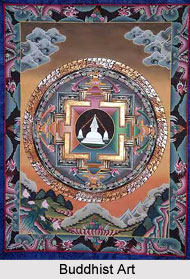 The historical and inspiring life of Gautama Buddha had generated the concept of Buddhist art in India. With the spread of Buddhism and the Indian culture to other parts of the world, particularly in Asia, Buddhist art has also evolved over the periods. According to Buddhism, each of the five basic colours, the Pancha-Varna, white, blue, yellow, green, red, has special significance and depicts a celestial Buddha, and a state of mind and soul.
The historical and inspiring life of Gautama Buddha had generated the concept of Buddhist art in India. With the spread of Buddhism and the Indian culture to other parts of the world, particularly in Asia, Buddhist art has also evolved over the periods. According to Buddhism, each of the five basic colours, the Pancha-Varna, white, blue, yellow, green, red, has special significance and depicts a celestial Buddha, and a state of mind and soul.
The concept of Rainbow body, state of meditation, in Buddhism, is the penultimate and transitional form, where substance is converted into pure energy of light. The details and shades of the colours may vary but the number of five basic colours remains static. There are five different aspects of the transcendental Buddha-
* The white bodied, Vairochana
* The Blue bodied, Akshobhya
* The yellow bodied, Ratnasambhava
* The Green bodied, Amoghasiddhi
* The Red bodied, Amitabha
Each of the Buddhas and their respective colours are believed to initiate the process of converting particular negative human emotions into positive traits, by just meditating on a particular colour. The symbolism and transformative properties of each colour are mentioned below:
White
White is which is comprised of all other colours and occurs when the entire spectrum is viewed collectively. Thus it is considered that every aspect is present in this colour. White is assumed to possess the qualities of extreme cold, as in ice, and excessive hot, like a blazing metal. Both the extremes can be life saving as well as fatal. White not only involves the entire spectrum but also has the ability set matter apart and brings termination to anything, including life. White is inherently involved in Buddhism, the most renowned being the birth of Siddhartha.
Blue
According to Buddhism, the colour Blue, both light and dark shades, are of ample significance. Blue is generally associated with infinity, healing, coolness and purity. But it is also believed to harbour the emotions of anger and rage. In Buddhism, meditating on the colour can transform such negative feelings into clear wisdom and purify and heal the soul. Turquoise, which boasts the lighter shade, is believed to reassure a secure journey when used in the form of a ring, and if the stone is found, then it is believed to fetch good luck. The Blue Buddha or the healing Buddha depicts the influence of the darker shade in Buddhist art. This colour signifies the pure and rare.
Yellow
Due its close resemblance with daylight, yellow is considered to the most symbolic value in Buddhism. All the Buddhist monks usually wear saffron robes which depicts renunciation, desirelessness and rootedness. Gautama Buddha selected yellow, which signified his modesty, humility severance from materialistic world. Yellow, the colour of earth, denotes equability and calmness on earth.
Green
The colour green appears in the middle of the seven coloured spectrum or the rainbow, and thus denotes the traits of equilibrium, balance, stability and harmony. Green is the colour of nature and symbolises vigour, youth and activity. Meditating on green can transform feelings of jealousy into wisdom of accomplishment. Amoghasiddhi, restates that green is the colour of action.
Red
The colour red is considered as the colour of passion, life, preservation, fire, and the sacred and is believed to transform illusion of attachment into the wisdom of judgment. Red is seen as the colour of rituals. The precious coral, which encompasses red, is believed to instil flexibility and flow and signifies energy of life force. It is believed to possess the protective qualities. Amitabha embodies this colour, and thus red is the only other colour which can be seen in monk`s robes and garments.
The symbolism of the red colour is illustrated in Buddhist painting type of Red Thangkas, which necessitates expert technical intelligence. All the elements in this style of painting include shades of red in some way.
Other than these the colour black is also worth mentioning in Colour Symbolism in Buddhist art.
Black
Black denotes the primal darkness. Paintings in black, which appeared relatively late in Buddhist art, provided another dimension to artists to illustrate magnificent worlds. The aggressive deities who are portrayed in the Black Thangkas portray the inner darkness of hate, jealousy and ignorance, and also it`s importance in the re-emergence of truth and purity. Black symbolises of hate, and transforms hate into compassion. Darkness embodies the immediacy of the supreme.
It is stated in the Mahavairochana-Sutra, that the Mandala, the symbol of Tibetan Buddhism, should ideally be portrayed in 5 colours. According to then The Chakrasambhara-tantra, the Mandala, painted in 5 colours, should use black in the core followed by white, yellow, red and green. In particular Mandalas, different directions are portrayed in different colours, like east is indicated by white, west by red, north by green, and the south by yellow while the centre is painted blue. But a different routine is suggested by the Kalachakra-tantra, the black signifies east, yellow signifies west, white signifies north, and red indicates the south. The protecting circle of a Mandala is typically portrayed in red. The elements of fire, water, air and earth are also shown with four separate colours, red, white, blue and yellow respectively.
Buddhist art have been modified from basic conventional principles, and it has never bothered to imitate or portray the outside world. The main objective of Buddhist painting was to arouse beaming internal symbols, in order to enhance the mind, body and soul with the teachings of Buddha and the principles of Buddhism.




